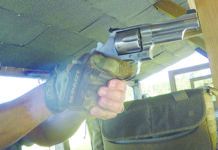Truth be told, there is no shortage of good rimfire rifles. Bolt-action or semi-automatic, the majority of 22 LR and 22 WMR rifles are capable of delivering tight groups from distances of 50 yards or more. While such rimfire rifles may be plentiful, good 22 LR ammunition has, for some reason, become scarce. Nevertheless, many smallbore hunting devotees would rather be shooting a more powerful cartridge anyway. Enter, the 0.172-inch-diameter bullet and caliber 17 HMR or Hornady Magnum Rifle and a pair of bolt-action rifles from Sturm, Ruger and Browning.
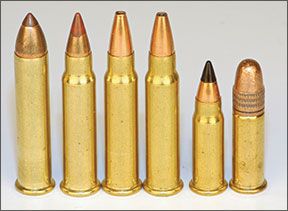
The Ruger 77/17 follows the pattern of Ruger’s full-size bolt-action rifles. Our test rifle featured a laminate stock and scope mounts integrated with the receiver. Barrel length was 24 inches with a noticeable taper. The Browning T-Bolt Target Varmint fired from a shorter 22-inch barrel that was closer to a bull-barrel profile. Despite a mere 2-inch difference in barrel length, the T-Bolt seemed much more compact. Perhaps it was the Browning’s Monte Carlo walnut stock that gave us this impression.
Both test rifles fed from removable magazines that stored rounds in a rotary pattern, and that allowed them to fit flush or nearly so with the bottom of the stocks. The most obvious difference between the two rifles was their bolt-action designs. The Ruger worked from a traditional pattern that required a short throw upward, back, forward, and down. The Browning T-Bolt required only a straight pull rearward and then a straight thrust forward to cycle the action.
We had no trouble finding a variety of loads for the rifles, including one from Hornady Manufacturing that was topped with a 15.5-grain NTX (non-toxic) bullet. We also purchased Winchester’s 20-grain GamePoint (hollowpoint) ammunition. Finally, we chose Federal Premium ammunition that launched a 17-grain TNT hollowpoint made by Speer to represent the caliber’s traditional bullet weight. We wondered if the small difference in bullet weight would make a big difference in accuracy.
For optics, we chose the same Nikon 4-16X42mm SF Monarch scope that was used in our recent test of a CZ USA 204 Ruger centerfire rifle. As in that test, we found that 50-yard targets were no challenge at all. Rather than assemble accuracy data that would divide the two rifles by the hundredths of an inch, we posted targets on the 100-yard boards of American Shooting Centers in Houston. And, as we did with the 20-caliber CZ rifle, we planned to test the capability of each rifle on the 200-yard range as well by using the BDC (Ballistic Drop Calculator) reticle.
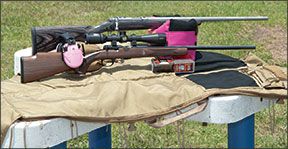
Given the few but starkly contrasting designs of our two rifles, we wondered if either design would prove to be more efficient than the other. Would the Browning’s straight-pull T-Bolt prove to be a gimmick, or would it provide a distinct advantage? And, given the variety of bullet shapes, specifically at the tip of each slug, would both guns be able to smoothly cycle all three choices of test ammunition and produce superior accuracy? Let’s find out.
Browning T-Bolt Target/Varmint No. 025176270 17 HMR, $799
Our first impression of the T-Bolt Target/Varmint was that of a very solid structure. The barrel was free floated with about nine dollar bills’ worth of gap between the barrel and the forend. The T-Bolt weighed just 5.7 pounds. Sharp checkering on the forend and on the pistol grip improved its field handling. The lines in the glossy walnut were deftly machine cut rather than stamped. Sling studs appeared front and rear. The plastic buttpad didn’t offer shock absorption, but none was necessary. But thanks to a knurled surface, the plate did offer some grip, and its retro styling added classic visual appeal.
The gold-colored trigger has become one of Browning’s signature accents. The trigger guard was made from polymer but resembled aluminum. The guard was held in place by two Allen stock bolts, but there was also a smaller Allen bolt seated in a brass collar immediately forward of the trigger guard. This was the trigger-pull adjustment screw. Adjustment range is listed as 3.25 pounds to 5.25 pounds. Our T-Bolt was tested with the trigger set at about 4.5 pounds as shipped. We found virtually no creep, just a precise, clean let off. We couldn’t ask for much more than that.
The T-bolt rifles feed from Browning’s double helix magazine. This consists of two rotors stacked one atop the other. The rounds feed into the rotors like the teeth in a gear and form an “S” shape as they snake from one rotor to the other. Loading was made easier by turning the manual assist located at the rear of the magazine body. But the extra help was unnecessary. Magazine fit in the stock was not quite flush, but this didn’t interfere with bench or bag support, and we liked the ease with which the magazines entered and released from the receiver. Magazine capacity was 10 rounds. Only one magazine was supplied, and extras cost $70, which is a expensive, in our view.
The straight-pull bolt action required only about 1.6 inches of travel forward and back. But this was not the time to be subtle. The more swiftly we moved the bolt, the more positive the cycling. Although not the same mechanically as the high-end Blaser (pronounced Blah-zur) rifles or rifles commonly used in Olympic biathlon, the result was much the same. Thanks to linear action of the bolt, it was very easy to refill the chamber with minimum disturbance to the sight picture. Feeding from the double helix magazine was reliable and responsive, no matter how fast we worked the bolt.
Removing the bolt for cleaning and inspection was not quite as straightforward as simply working a lever while withdrawing the bolt. The regimen was to turn on the safety and pull back the bolt only enough to unlock it from battery. Then reach beneath the tail of the bolt and press the silver-colored release downward while pulling the bolt free. With the lever on Safe, the shooter could easily reinsert the bolt and return the action to battery. The one key to reassembly was to make sure the bolt handle was in the open position.
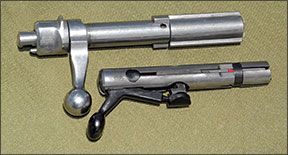
The receiver was drilled and tapped for scope mounts. We found that compatible two-piece Weaver mounts were easy to find. We used Warne Maxima mounts to match our Warne Maxima rings and were very satisfied with both the strength of this setup and the ease of installation. At the range we achieved our best results firing the Federal Premium 17-grain TNT hollowpoint rounds. Even at 100 yards, our accuracy data was divided only by tenths of an inch. The Hornady 15.5-grain NTX rounds delivered 1-m.o.a. accuracy on average, but the 20-grain rounds from Winchester didn’t seem as agreeable, firing an average group computed to be about 1.2 inches center to center. Actual smallest and largest five-shot groups fired from the Browning T-Bolt Target Varmint measured 0.8/1.1 inches, 0.6/1.0 inches and 1.1/1.4 inches for the 15.5-grain, 17-grain, and 20-grain rounds, respectively. Despite the growing availability of alternative bullet weights for 17 HMR ammunition, the 17-grain slug, which was the original commercial offering, seemed to be the best choice. In fact, when firing the 17-grain rounds and aiming with the first BDC circle in the Nikon, our shots proved dead on from 200 yards.
Our Team Said: The straight pull of the T-Bolt may afford the shooter the fastest way to engage multiple targets outside of a semi-auto, making it a great pick for squirrel hunting or prairie dog hunting at closer range. But even if you don’t hunt, this is a rimfire rifle that is hard to beat for sheer fun. It was a treat to set up a row of cans or clays and see how fast we could mow them down — or, thanks to the impact of 17 HMR — blow them up. We’d want to have extra magazines, but they are expensive. Then again, the double-helix magazines were so reliable, easy to refill, and replace in the receiver, they’re probably a bargain despite the cost.
Ruger 77/17 Rotary Magazine Rifle K77/17VMBBZ No. 7027 17 HMR, $969
The 17 HMR may not be a typical rimfire cartridge, but neither is the Ruger 77/17 a typical rimfire rifle. This is a 7.4-pound rifle (without scope) with a lengthy 24-inch barrel housed in a full-length laminate stock. It may be thin around the pistol grip, but it is far from being a youth model.
The Ruger 77/17 rifles are available with a choice of three different stocks. The American walnut stock was the lightest of the three, weighing about 1 pound less than the black-and-green laminate stocks. The laminates cost about $70 more, too. But they are striking. The Green Mountain is more colorful, but the black laminate of our test model was a good match for the matte-stainless finish of the action and the barrel. There was a small gap between the barrel and the forend over the span of about the final 2 inches, but this was not a free-floated barrel. A rubber buttpad capped the hefty stock.
The receiver of our rimfire rifle seems to be just as big as on some centerfire models. The bolt featured a 0.75-inch-diameter ball on the end of its flattened stalk. Movement of the bolt was a rather short arc, only from about 4 o’clock to 1 o’clock, and cycling was extremely short. Bolt travel was less than 1.9 inches, and cycling was noticeably smoother when loaded with the closed tip rather than hollowpoint bullets. Working a latch simplified bolt removal. The latch consisted of a spring-loaded piece of flat stock inlet on the left side of the receiver. Operation required a fingernail or small object to push it downward.
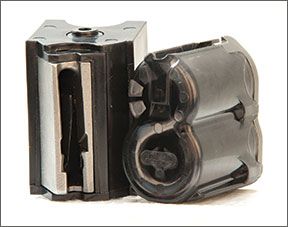
The top of the receiver accepted Ruger’s supplied proprietary rings. At its central position, the three-position safety allowed for working the bolt with the trigger held in check. The trigger was not user adjustable, so we tested it as delivered, 5.75 pounds.
The lone supplied magazine held nine rounds. Extra magazines cost only $25 apiece from ShopRuger.com. The magazine fit flush with the bottom of the receiver. The magazine release consisted of a panel located behind the magazine well that hinged inward away from the magazine body. You can operate the release and control the magazine by plucking it with the thumb digging in from the rear with the index finger grasping the magazine body from the front. If you are worried about wrecking a manicured thumbnail perhaps you will want to have a drop-bar release or other aftermarket design installed, such as those from Clark Custom Guns.
At the range we felt satisfied with the trigger and our physical set up utilizing Caldwell’s new $25 DeadShot front shooting rest. The only place we seemed lacking was in support for our primary hand. The pistol grip, though effectively checkered, was too narrow to fill our palms. To help us isolate our trigger finger from the chore of gripping the stock, we installed right-hand Kick-EEZE Hand-EEZ palm swell (440-705-100WB, $14 from Brownells). This left us with the pad of our index fingers resting across the face of the trigger. Immediately our accuracy improved.
The Ruger shot the Federal Premium 17-grain TNT rounds to slightly less than 1 minute of angle on average. In fact, all our groups firing this round were measured between 0.9 inch and fractionally more than 1.0 inch across. We did land one 0.7-inch-wide group firing the 15.5-grain non-toxic rounds to anchor an average size group of 0.9 inches, but we had the most sub-MOA groups firing the 20-grain rounds. The Winchester 20-grain GamePoint hollowpoints also produced the most muzzle energy.
Also, the Ruger’s 2-inch-longer barrel produced more velocity with all three test rounds. In the Ruger, the heavier 20-grain bullet showed a net velocity advantage of 209 fps when compared to the Browning’s (2590 fps to 2381 fps) — a gain of more than 100 fps per inch of barrel length. The margins weren’t as big with the lighter rounds, a 95-fps edge for the Ruger with the 15.5-grain Hornady bullets and a 106-fps advantage with the 17-grain Federals, or around a 50-fps velocity gain per inch for the Ruger.
Our Team Said: This is truly a full-size rifle built to maximize the potential of the cartridge. Overbuilt might be one way to describe it. Magazine capacity was slightly lower, but Ruger’s single-spool rotary magazines are reasonably priced, so carrying extra magazines for small-game hunting shouldn’t be a concern. But this is not a quick-cycling rifle. In fact, only the closed-tip bullets managed to avoid stuttering and double clutching the bolt. What the 77/17 does better than the Browning is make full use of the 17 HMR powder charge and extend its range.
Written and photographed by Roger Eckstine, using evaluations from Gun Tests team testers.






